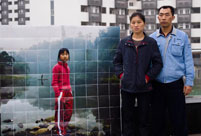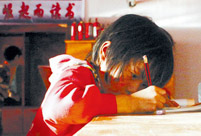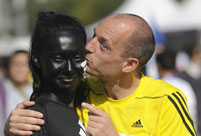Turin, October 24 - Celebrated as one of the greatest modern painters for his work as an Impressionist, as well as for the uncompromising aesthetic of his late artwork, Pierre-Auguste Renoir (1841-1919) spent his life moving from style to style, inspired by a number of contemporaries and masters of the past, developing his trademark fluttery brushwork.
An exhibit at Turin's Gallery of Modern and Contemporary Art (GAM), which opened Tuesday and runs to February 23, showcases 60 paintings from Paris' d'Orsay and Orangerie museums covering key moments of the French artist's career.
Most of the artwork has never been shown in Italy before.
Organized by Sylvie Patry and Riccardo Passoni, the exhibit highlights the complexity of the artwork of one of the founding members of the Impressionist movement, who ceased to exhibit with the group after 1877 and from the 1880s developed a style of classical inspiration that influenced artists like Pablo Picasso.
''With the collections from the two Parisian museums, we can show Renoir's work in its diversity and richness,'' said Patry and Passoni.
With a career spanning half a century, from the 1860s until after World War I, Renoir produced over 5,000 paintings, drawings and watercolours ranging from landscapes to portraits and nudes.
The son of a tailor, Renoir was the only major Impressionist from a working class background and the only one who worked as an artisan before taking up a career in fine art.
During most of the 1850s, he worked in factories, painting china.
The Turin exhibit embraces Renoir's penchant for portraiture - which attracted the attention of a number of patrons ranging from society lady Madame George Charpentier, whose portrait can be admired at the show, to the politically radical Eugene Murer - with a wonderful gallery of women's portraits like Madame Darras, La Liseuse, a Young Woman with a Veil.
Renoir painted more portraits than any other major Impressionist.
The show's Bohemian Age section features one of the artist's first nudes, while the Le Metier de Paysagiste section includes 10 paintings from the d'Orsay's magnificent collection of landscapes.
La Recherché Heureuse du Cote Modern part showcases the outstanding painting The Swing. Another section is dedicated to children's portraits - including the Clown, featuring his son Claude, and the enchanting Genevieve Bemheim de Villers - which best embody the artist's romantic, idealised impulses.
The section Beau comme un Tableau de Fleurs highlights the striking quality of the technique and colours in flower paintings, while an entire room is dedicated to nudes, including the outstanding Grand Nu.
The Bathers' Inheritance closes the exhibit with one of Renoir's most famous paintings, Bathers, widely considered Renoir's testament, which his three children donated to France in 1923.
The Rubenesque nudes he had been painting culminated in the massive Bathers admired by Henri Matisse, the mature, monumental style influencing a giant like Picasso.
To the end of his long life, when he was considered one of the greatest living painters, Renoir retained his unpretentious speech and passion for artistic experimentation which permeates the show.
 Annual airshow kicks off in Houston
Annual airshow kicks off in Houston U.S. Navy Carrier Strike Group stages military exercises
U.S. Navy Carrier Strike Group stages military exercises Volkswagen showcases new energy vehicles in Beijing
Volkswagen showcases new energy vehicles in Beijing  Different eye catching shows at housing fairs in China
Different eye catching shows at housing fairs in China Special family portraits call attention to left-behind children
Special family portraits call attention to left-behind children Migrant children’s pain and joy in city
Migrant children’s pain and joy in city Lingerie show dazzles Wuhan Motor Show 2013
Lingerie show dazzles Wuhan Motor Show 2013  Running in fun customs at Beijing Int'l Marathon
Running in fun customs at Beijing Int'l Marathon  Weekly Sports Photos
Weekly Sports Photos Unveil PLA air force base
Unveil PLA air force base  World has never been dark-- a blind kid’s life in Tibet
World has never been dark-- a blind kid’s life in Tibet Oriental education or western education?
Oriental education or western education? China in autumn: Kingdom of red and golden
China in autumn: Kingdom of red and golden Pet costume competition
Pet costume competition Chinese screen goddesses from Beijing Film Academy
Chinese screen goddesses from Beijing Film Academy Day|Week|Month